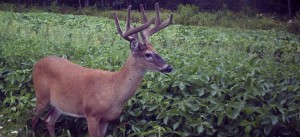Hot food sources for deer
Keeping Up With Hot Food Sources
By Steve Bartylla
Having just settled into the stand, I spotted three deer dashing through the fresh snow. Scanning the landscape behind them, I was at a loss to explain what had inspired their apparent flight from danger. Moments later, I saw I was mistaken. The drawing power of the standing soybeans had inspired the does’ run to feed.
As mildly surprising as that was, it didn’t compare to what happened several minutes later. There, nearly three hours before dark, was a mid 150ies ten point, also running to the beans! Within 15 minutes after hanging the stand, I had a definite shooter 12 yards away, offering an easy chip shot.
Now more interested in enjoying what promised to be a thrilling afternoon, I decided to pass the shot and see what would transpire. After all, I’d been looking forward to hunting my friend, Les Davenport’s Illinois property every since my late summer visit to his cabin. With my January trip finally here, I was intent on savoring at least the full first afternoon.
Though Les reported the 4-acre standing soybean plot had been receiving some sporadic feeding activity, we both knew the fresh dumping of 3 feet of snow would change all that. The big oak woods flanking the beans had produced a bumper mast crop that year. With plenty of acorns still on the ground, they’d previously offered the deer a highly desirable and more secluded feeding option. Overnight, the blizzard’s dumping effectively removed that option, along with essentially eliminating the waste in the surrounding crop fields. Just that quick, the standing beans had become the best choice.
Despite the snow also removing almost all the deer sign, thinking that through was all it took to determine the area I’d target. Over the course of my four day hunt, not only did I watch the beans vanish, but I also saw between twenty and fifty deer each sit. Among them was two more brushes with the 150ies ten and very close calls with a high 160ies buck and another that would certainly make Boone & Crockett. Outside of my first encounter with the ten, none of them offered ethical shot opportunities, and I left with an empty tag. However, to this day, it’s still one of the most exciting and fulfilling hunts I’ve ever experienced. It also beautifully illustrates the importance of keeping up with hot food sources.
Understanding The Sliding Scale
It shouldn’t be surprising that whitetail’s are driven by their stomachs. Even during the rut, bucks engage in some feeding activity, and food continues to play a vital role in the lives of the does they chase. That makes it obvious that knowing what the deer will feed on heaviest is invaluable during the entire season.
That begs the questioning of what is the deer’s favorite food. The easy answer to that is acorns. However, the more accurate answer is the best available feeding options on any given day.
Deer rarely feed exclusively on one food. Even in the case of the Illinois hunt, I spotted deer nibbling on woody browse and picking at the few available locust pods. Being ruminants, deer are able to digest plant matter with tough cell walls. Additionally, nature requires they eat diverse diets to fully meet their nutritional needs. The combination allows deer to eat most types of plant matter, and they do.
However, they’re still drawn to certain foods more than others. Part of this is due to seasonal shifts in nutritional needs. For example, minerals and high protein levels are more critical during the spring’s milk production and antler development stages than during late fall and early winter. At that point, diets high in carbs and fats provide the ability to fatten up for winter. Because of that, it’s relatively safe to assume that even if freshly matured corn and acorns were available in May, their drawing power would be reduced. Certainly, deer would still consume them, but not as much as the fresh growth and high protein content of tender greens. A similar shift is seen in fall from protein rich greens to high carbohydrate and fat rich foods.
The food’s maturation stage also affects its desirability level. Most greens are most desired when in young, tender, rapidly growing stages. Generally speaking, during this growth stage they are most easily digested and experience high protein levels. As they reach maturity, they fall in both. On the flip side, mast and crop seeds aren’t typically as sought after until the reach full maturity.
Note that I said crop seed. Many crops, such as soybeans, wheat and rye, provide food in the form of the growing plant and dried seed. In that case, both their vegetative growth and seed independently experience stages at which they are most desirable.
Next, we must factor in what else is available. The beans I hunted in Illinois had been fully mature for 3 months before I hunted them, yet they still offered a surplus of beans. In the week before the snow, deer were still able to feed on acorns, locust pods, some green growth and corn waste, just to name a few options. After the snow, the only foods left in comparative abundance were woody browse and the standing bean plot. That catapulted the beans from a midrange option directly to the top rung, as evident in the field being wiped out in less than a week’s time.
Two final factors must also be considered. The first is the food source providing relatively easy and safe access. The easier it is to get to and safer deer feel while feeding there the more desirable the food source becomes.
Lastly, the overall health and condition of the food crop plays a role. All else being equal, a properly maintained and treated alfalfa field will be selected over one growing in acidic, low fertility soil and allowed to go to seed. Fresh, healthy acorns draw incredibly better than rotten or wormy options. To truly answer which feeding option is currently the most desired, one must consider all these factors.

Making The Right Prediction
Before a hunter can predict which local food sources are likely to draw deer during various phases of season they must know what will be available, its growth cycles and relative health. Summer is a great time to start on these tasks.
Because it’s fairly self-explanatary, I won’t waste much space on how to gauge farm crops. The biggest tasks here are to determine what was planted where and when, as well as if the crop is thriving. Asking the farmer questions and inspecting the crops will provide those answers.
After that, it mostly comes down to understanding which draws best when. As a general guideline, alfalfas and clovers are good bets early in season. Furthermore, my experience has been that they draw even better during and right after rains. Soybeans are great up until they begin to brown and then draw again after they completely dry. Where as corn and sorghum are best later, when fully matured and dry. Of course, these are just general guidelines. Some feeding activity will undoubtedly occur all season, and, if they lack competing food sources, that feeding activity can be significant the entire season.
Native food sources are a little trickier. Generally keeping tabs on the growing season’s weather patterns can be helpful. If the growing season is too wet or too dry, nature’s crops will suffer just like farm crops. Because the health of plants has a direct impact on its nutritional values, factoring this in helps lead us to which sources will likely draw best. All else being equal, during years with harsh droughts, common sense says that potential food sources in low ground will draw better. The reverse is true for extremely wet years.
Like farm crops, grasses and weeds are typically best early in season. The meadow or set-aside field may look brown and dead, but a closer look shows it’s teaming with cool season grasses and forbs. In spring, applying a lawn fertilizer to a half-acre or so is a great trick to draw feeding to a specific location. Cutting that same area two or three times over summer and fall, in the same way farmers cut hay, keeps it in its highly desirable state and makes it even better.
Most soft and hard mast is hard to beat at anytime it matures. The trick is determining whether it’ll be a good or bad crop. Inspecting the trees in summer for mast will answer that question. Glassing oaks for acorns can be particularly helpful. If it appears that the mast crop will be poor, finding the few oaks that will produce good crops has put me in a surplus of deer many times. It also avoids wasting time on an oak ridge that isn’t yielding acorns.
To help boost the mast crop in specific areas, drive fruit tree fertilizer spikes around the drip line. Just remember that it’s important to only do this in spring. A sudden boost in fertility during summer or fall can result in fresh growth that’s susceptible to frost damage.
As one may expect, woody browse increases in appeal as the other food sources dwindle. However, it’s always a mistake to ignore 1 to 5 year old logging areas. Here, the bevy of grasses, vines and berries offered, combined with the woody browse, makes these locations a powerful draw all season long.
Finally, keeping hunting logs is beneficial in many ways, but none more so than nailing hot food sources. In your logs, include what foods the property offers each fall and when you witness feeding activity on each. Doing this creates a timeline for what draws when. With that, we can become proactive hunters. Reacting to feeding activities can work, but often leaves us in the too late too late category.
Conclusion
Since food plays such a critical role in whitetails’ lives, it only makes sense that knowing what deer are most likely to be feeding on at any given day provides a huge advantage. Of course, there will always be exceptions and the best we can hope for is to nail feeding tendencies.
However, I believe hunters would be amazed at how many more deer they’d see if they’d only shift a fraction of the time they spend scouting deer towards scouting food sources. Most of us have a decent handle on food sources. Just think of the result made possible by changing that to a firm grasp.
For a comprehensive guide to cutting edge stand hunting methods, check out Steve Bartylla’s book. A full-colored, personally autographed copy of Advanced Stand Hunting Strategies, can be purchased by sending a check or money order, for $22.50, tax and shipping included, to the following:
Steve Bartylla
909 N Chestnut Ave.
Marshfield, WI 54449
Be sure to include your name and the shipping address.


